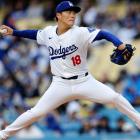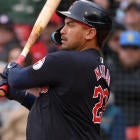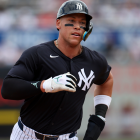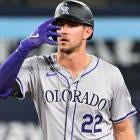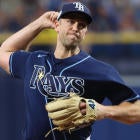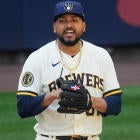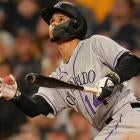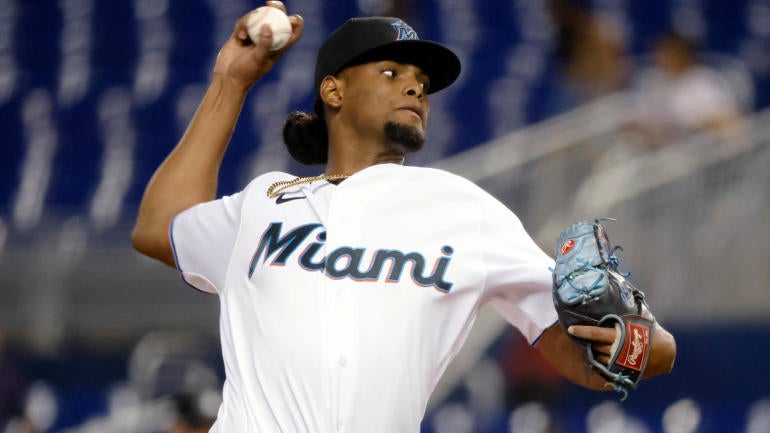
Well, it happened. Edward Cabrera is a major-leaguer. Whether he's one deserving of your time yet is another matter.
His debut Wednesday was a mixed bag. The line was good enough -- a quality start, technically, with three earned runs allowed in 6 1/3 innings -- but the ways he stood out weren't really the ways we were expecting him to stand out.
Efficiency is how he made it happen. Despite issuing 5.8 walks per nine innings during his time at Triple-A Jacksonville, he made it five innings without walking a single batter in this one, his pitch count sitting at around 50 at that point. He ended up throwing just 78 pitches in 6 1/3 innings. Still, the walks eventually came, three in all, and he also served up two homers before his day was done. It seemed like that third time through the lineup just didn't agree with him, which is a typical hurdle for a pitcher just breaking in.
But what to make of the rest of it? The pitch-to-contact, put-the-ball-on-the-ground approach is one that could work for Cabrera. For as electric as his fastball is, occasionally topping triple digits, it has good sinking action. It's part of what makes him so appealing, the ground balls representing a potential path to success on their own.
Still, it's not what got us excited about him. What got us excited was his 13.5 K/9 in the minors this year. What got us excited were the three double digit-strikeout efforts in his final four starts leading up to the promotion. We expected him to be overpowering, if erratic, and for at least this one start, he was the complete opposite, coaxing just four swings and misses on his 78 pitches against a lineup that featured many of the same caliber of player he was facing in the minors. That he ended up walking three anyway made it certainly an unworthy tradeoff.
Bottom line is I need to see more before I make Cabrera a priority on the waiver wire. His debut could have gone worse, of course, but he didn't convince me he's going to rise to the challenge either. As things presently stand, he's in line for two starts next week, but there's of course no guarantee he makes them, particularly with Trevor Rogers looking to rejoin the rotation.
Five on the verge
(These are the prospects most worth stashing in redraft leagues.)
Bobby Witt, SS, Royals
2019 minors: .262 BA (164 AB), 1 HR, 9 SB, .670 OPS, 13 BB, 35 K
2021 minors: .297 BA (381 AB), 27 HR, 21 SB, .955 OPS, 37 BB, 101 K
At this point, I'm pretty confident Witt won't be getting the call this year, and yet I think so little of my opinion that I'm going to rank him first here anyway -- thus ensuring I'll be "right" either way. OK, so it has less to do with any of that than with Witt's potential for impact, which is of course considerable. The whole reason you stash a prospect ahead of time is because you hope he'll be a difference-maker when he arrives, and among those with any hope of coming up still, Witt has the best chance of that. His move up to Triple-A a month ago hasn't slowed him down at all. He's batting .299 (41 for 137) with 11 homers, seven steals and a .983 OPS there.
Keibert Ruiz, C, Nationals
2019 minors: .261 BA (314 AB), 6 HR, 9 2B, .679 OPS, 30 BB, 22 K
2021 minors: .313 BA (272 AB), 21 HR, 24 2B, 1.010 OPS, 28 BB, 33 K
Ruiz is coming off back-to-back two-homer games, continuing a stark turnaround from his earliest days in the Nationals farm system. His slash line there (.318/.366/.636) now looks about like it did with the Dodgers (.311/.381/.631), which might be enough to convince the Nationals he deserves a late-season look. They didn't hold Josiah Gray back for service time reasons, after all, and Ruiz himself has already gotten some major-league experience.
Keibert Ruiz hit 2 home runs for the 2nd day in a row? Keibert Ruiz hit 2 home runs for the 2nd day in a row! #Nationals pic.twitter.com/KT3T39AguE
— Rochester Red Wings (@RocRedWings) August 25, 2021
His power breakthrough this year has taken his prospect stock to another level, but it was his bat-to-ball skills that put him on the map in the first place, his 10.9 percent strikeout rate pointing to what could be an easy big-league transition.
Jose Miranda, 3B, Twins
2019 minors: .252 BA (445 AB), 8 HR, 26 2B, .671 OPS, 24 BB, 54 K
2021 minors: .339 BA (404 AB), 25 HR, 24 2B, .986 OPS, 36 BB, 60 K
As with Witt, I kind of feel like if the Twins were going to call up Miranda, it would have already happened by now. But there is still such a thing as a September call-up, and the Twins may want to go into the offseason having some idea how much they can count on Miranda for next year. My feeling is "a lot." In fact, I recently nominated him as the third baseman we're likely to regard as a stud at this time a year from now. It's hard to find any flaws in his game offensively. He has easy power even to the opposite field and a tremendous grasp of the strike zone that's followed him from the lower minors.
Seth Beer, 1B, Diamondbacks
2019 minors: .289 BA (450 AB), 26 HR, 24 2B, .904 OPS, 46 BB, 113 K
2021 minors: .289 BA (325 AB), 15 HR, 30 2B, .915 OPS, 34 BB, 67 K
Beer has slowed his roll a bit over the past week, but not enough that it should change the Diamondbacks' timeline for him. He's not a highly regarded enough prospect for them to play service time games with him, and he's just a couple weeks away from turning 25. Christian Walker is taking up space at first base at this point, his OPS sitting at .660, so it seems inevitable Beer will get a look at some point over the next five weeks. And then we'll find out if he's another one of those slugging first basemen who traditional rank lists so often sell short.
Vidal Brujan, 2B, Rays
2019 minors: .277 BA (383 AB), 4 HR, 48 SB, .735 OPS, 37 BB, 61 K
2021 minors: .289 BA (287 AB), 9 HR, 33 SB, .856 OPS, 39 BB, 43 K
At this time a week ago, Brujan looked like he was cooling off, but he's suddenly surging again, batting .304 (7 for 23) over his past six games. And hardly a day goes by without him stealing a base. In 25 games since returning from his unsuccessful stint in the majors, he's batting .347 (34 for 98) with 15 doubles and 18 stolen bases ... but no home runs. Yeah, those seven he hit in April were clearly a red herring. Still, he's more than just a burner, actually walking (14) more than he's struck out (nine) since his return. He would indeed have some value if the Rays brought him back as a speedy utility player down the stretch.
Five on the periphery
(These are some other prospects doing something of note)
Nolan Gorman, 2B, Cardinals
2019 minors: .248 BA (456 AB), 15 HR, 30 2B, .765 OPS, 45 BB, 152 K
2021 minors: .280 BA (368 AB), 20 HR, 13 2B, .824 OPS, 33 BB, 93 K
It's becoming apparent from his recent work at Triple-A Memphis that Gorman is one of those prospects who doesn't transition so easily from level to level, needing a lengthy adjustment period to find his footing. But now that he has found his footing, the 21-year-old is batting .316 (48 for 152) with nine home runs in his past 38 games. Most importantly, he's striking out just 16.9 percent of the time during that stretch. If contact isn't going to be an issue for him, the power output could be something unlike the keystone has ever seen.
Nick Gonzales, 2B, Pirates
2021 minors: .291 BA (254 AB), 10 HR, 18 2B, .868 OPS, 25 BB, 81 K
The seventh overall pick in last year's draft needed some time to settle in, especially after missing more than a month with a shoulder injury, but he's rolling now, batting .357 (49 for 137) with five homers and a 1.005 OPS over his past 33 games. Of course, for a player who's supposed to stand out for his hit tool, not really projecting for big power, his 28.6 percent strikeout rate does raise a red flag, especially when you consider he's a 22-year-old at high Class A. Still, he looks like the sort of player who'll have a consistently high BABIP thanks to his natural line-drive stroke.
George Valera, OF, Indians
2019 minors: .217 BA (180 AB), 8 HR, 6 SB, .748 OPS, 31 BB, 61 K
2021 minors: .261 BA (207 AB), 16 HR, 10 SB, .971 OPS, 56 BB, 60 K
Forget about what he's doing with the bat for just a second. Valera is proving to be an offensive asset just by keeping it on his shoulder. He now has 21 walks over his past 18 games, going without a walk in only five of them. In fact, his .430 on-base percentage at high Class A just got him promoted to Double-A. All the walks make his at times suspect strikeout rate more palatable, and for a 20-year-old being thrust into the upper minors, that rate isn't so bad anyway. Those who don't nerd out on things like OBP will be happy to know he also has a pretty left-handed swing that results in hard contact to all fields.
Dustin Harris, 1B, Rangers
2019 minors: .325 BA (209 AB), 1 HR, 9 SB, .810 OPS, 25 BB, 39 K
2021 minors: .333 BA (330 AB), 16 HR, 24 SB, .954 OPS, 40 BB, 59 K
Harris was who the Rangers got back from the Athletics in the Mike Minor deal last year, and he may be turning himself into a legitimate prospect. True, he's a 22-year-old still toiling in the lower minors, but he's only gotten better since his move up to high Class A, batting .451 (32 for 71 ) with six home runs and a 1.262 OPS. The contact rate supports him hitting for average, and the power has been better than expected, buoyed by the Rangers' efforts to improve his launch angle. First basemen have a narrow path to the majors, but Harris looks to be creating one for himself.
Drey Jameson, SP, Diamondbacks
2019 minors: 0-0, 6.17 ERA, 1.97 WHIP, 11 2/3 IP, 9 BB, 12 K
2021 minors: 4-4, 3.34 ERA, 1.10 WHIP, 91 2/3 IP, 24 BB, 118 K
A smallish righty who routinely hits 98 mph with his fastball, Jameson has proven to be surprisingly durable, throwing six-plus innings in six straight starts. He has also been effective, recording double-digit strikeouts in four of those starts, including three of his four since moving up to Double-A. He has a full arsenal apart from the fastball, with MLB.com awarding a 55 grade to each of his curveball, slider and changeup. All things considered, it's surprising he doesn't show up higher in the prospect rankings, though it sounds like he has some issues locating his pitches even if they're generally in the strike zone.
















